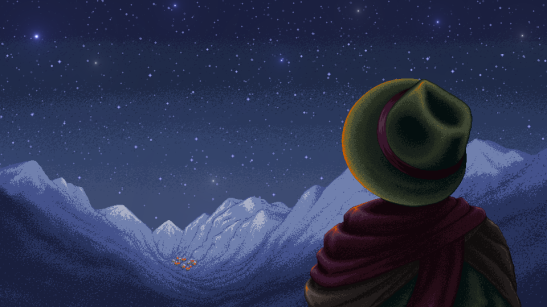Vidar is Dying
Hello everyone! My name is KT Babb, and I’m guest blogging for Out of the Woodwork today. A little about me: I’m a founding editor of the City Quill, a lit mag that publishes emerging writers from all over the United States. We’re heading into our second year as a publication and currently accepting submissions for our third issue, so if you’re a poet or writer who’s never been published before, you should check us out! Out of the Woodwork has been there to support the City Quill from the very beginning, and I’m excited to contribute to such an awesome platform.
For my very first guest post, I caught up with Dean Razavi, the ex-litigation attorney who quit his day job to pursue a very different passion—indie game development. His flagship creation is an RPG puzzler called Vidar, a game that grapples with some serious questions about mortality and what we should do with the time we’re given. We first talked with Dean back in January of 2015, just after he launched his Kickstarter campaign.
To recap, gameplay takes place in the little town of Vidar, an isolated village with a serious monster problem; every night, a loathsome Beast emerges from its cave and devours one of the town’s citizens. By the time your character, the Stranger, arrives in Vidar, the population has dwindled to just 24 people, and you have as many days to save the town from total destruction. Vidar has gained notoriety as the game where everyone dies, but the real kicker—and the game’s encompassing theme—is that death is unpredictable, even when you know it’s coming. The order of deaths in Vidar is totally random for each playthrough, and every death has its own set of consequences depending on who is left alive. After a successful Kickstarter campaign, endless hours of coding, and tons of beta testing, Vidar is finally ready for launch. Here’s what Dean had to say leading up to the release.
INTERVIEW
[KT] Way back in 2015, you gave us an overview of Vidar and what was going on in the world you were building. How have things changed since those early stages?
[Dean] I think more has changed in my world than in Vidar! Back in 2015, I was still a full time lawyer. I had very little understanding of good game design. I thought I could do this game in a single year. Well time makes fools of us all!
The biggest change to the world of Vidar since 2015, I think, is the dialogue. During the Kickstarter, each character was still more or less simply defined by their job. It’s important to step back for a second so I can explain that Vidar started as a very traditional RPG town, with a blacksmith to give you weapons, and an innkeeper, and all those kinds of things. And when the switch was made very early to a combatless game, a lot of those jobs still survived. Back in 2015, I didn’t understand most of these characters beyond those old jobs, and a need to give you a quest or seven.
Since then, I’ve had the opportunity to do a deep dive with each and every one of them. I found sources of fiction – whether in a book, on TV, or described in a song – to hunt for characters that were spiritual siblings to each of my 24. I understood their motivations better mostly so that I could write all of the dialogue, but in turn, they told me when their stories couldn’t go in a direction they wanted it to go. There have been moments when I’ve said ‘Dorottya wouldn’t just let that loose thread end like that, she’d hunt it to the end.’ So I’ve had to write more to let her be more true to herself. Finding everyone’s voice I think has made Vidar feel less like a generic fantasy town, and more like an actual one, and led me down some really cool paths that I wouldn’t have come up with on my own. I have the villagers to thank for that.
What would you say was the most challenging aspect of development?
My technical chops just aren’t even comparable to most people who are doing indie game development these days, and I know it. I am entirely self-taught on the engine (RPG Maker VX Ace) and the scripting language it uses (Ruby), and while I can kind of force it to do what I want, I don’t have the education on coding best practices. That means that there’s undoubtedly an easier way to do 99% of everything I’ve written, but I don’t know it. It’s made managing the scope of Vidar incredibly challenging. Even looking back at some of the old code I wrote 3 years ago, I have to laugh. It’s at least an indication that I’ve learned a lot, and hopefully things will go smoother on the next game.
One of the most important and intriguing features of this RPG is the way each character’s death can affect the other townspeople. How did you go about writing all those interlocking storylines?
All of my characters started with a core storyline I wanted to tell, or some unique in-game mechanic I wanted to explore. That meant I kind of had one thread already in mind for each of the 24. So for the clockmaker Sandor, I wanted to explore what happens when someone who considers themselves extraordinarily religious is dealt the absolute worst hand. A player might notice in his dialogue that I kind of leave the ‘parent-burying- a-child’ grief out of it, because that storyline is reserved for Csaba, a very poor mother.
Some older characters are preparing or prepared for death. With the soldier, Etel, I wanted to explore that mixture of cowardice, arrogance, and xenophobia that sometimes crops up on all of our Facebook feeds, and offer a way to resolve it. From there, I started looking for places where I thought intersections of these stories might be interesting. If Sandor is mourning but still is well-off, and Csaba is begging for scraps (and a bit indignant about it), how does that relationship play out? If there’s someone suffering from a long-term illness, isn’t it in the doctor’s nature to try to fix it, no matter what science says? How does that play out, in quest form? Answering all of those questions helped me flesh out the relationships between each character, rather than just focusing on their own storyline. And then, finally, I started looking for places where an important game mechanic would be disabled if a single person died. So, an example is the pocketwatch, which shows the timer in the cave. Not having it makes the game very different, because you’re estimating your time rather than having pinpoint accuracy. If the clockmaker dies the first night, it felt a little penalizing. So I added another moment where Cecilia wants to repair her now-dead father’s pocketwatch, to keep as a memento, and you can only get this quest if the clockmaker is dead. It’s harder than the first, to be sure, but it serves as a counterpoint mechanically. And it gave me another chance to explore Cecilia’s feelings about her dead parent’s, the focus of all of her character interactions.
So those were the three places that I looked to make sure the interlocking stories all worked: first to the character’s own storyline, then to their relationships with others, and then finally to gaps in the mechanics. Once those were roughly mapped out, I’ve also had to figure out a priority system. Each villager is only going to say one thing at a time – should they be talking about her recent dead sister, or about an outstanding quest, or…? This ended up being the hardest decision making as I went. If a villager could be used in three different quests, it was important that she be available for all three. Hopefully it feels like each is now talking about the most important thing at all times.
Tell me a little bit about your team. How did you manage the long-distance aspect of working together?
So, Becca Bair (the artist) lives in Austin, TX. Despite working on this game together since 2014, the first time we met was this past September, over two years later. Fortunately, she’s really understood my vision for a desaturated, depressed version of Final Fantasy 6 aesthetics, and has been able to translate my MS Paint stick figure scrawl into some things of real beauty. Adrian Jakubiak (the composer) lives in Poland, and we’ve never met! I have a music background, and actually had some demo tracks that I had written that I was using to demo Vidar at various showcases in early prototype phases. Even before I sent those to Adrian, though, he and I were on the same page – a small, intimate, chamber feel. He was able to distill my MIDI piano tracks to understand the feeling I was trying to get at, and then take it way further.
With both, it’s always been about the aesthetic point of view of the game. I throw around words like “grief” and “nostalgia” and “loss” and “bittersweet” (and, when talking about the themes of the game, rarely “death” itself because that’s a little too heavy metal for Vidar), but they’re incredibly important when talking about art and music. The art direction is supposed to be nostalgic, like looking back at your favorite golden-era, vibrant 16-bit RPG through a veil. The main town theme captures that lingering, perpetual grief with these drawn out strings that stick around just a bit too long, rather than trying to represent some kind of dark evilness or percussive panic. So communication was all about these theming words, which translate across pretty much every art form.
What are your plans for Vidar after its release? Do you see any DLCs or expansions in the future?
January 31 is just the Early Access launch. It’s a fun game, there’s certainly enough content to play several times through the game, but I still have ten content patches that I want to do while the game is in Early Access to complete what I’ve always seen as Vidar 1.0. I’ll be trying to release about one a month until the end of this year. After that, I don’t know! The nice thing about Vidar is, there’s always room for extra puzzles and extra quests and dialogue. You’ll never see all of them in a single game that’s very intentional. So supplementing at a later time just means a more robust game your 5 th time around. The exact model for that, if the game even needs them, is very much TBD.
Is there anything else you’d really like to share?
I’m listening to feedback, maybe more than I should. If Vidar provokes a reaction, good or bad, I want to hear it. If you don’t like something in particular, for the love of everything tell me. I’d love to address it in Early Access!
FINAL THOUGHTS
As a serious RPG nerd, I’m stoked to sink my teeth into Vidar and all it has to offer. With an ever-changing gameplay experience, plus golden-era graphics, thought-provoking themes, and new twists on the classic puzzler style, it sounds like a winner to me.
-KT




Recent Comments